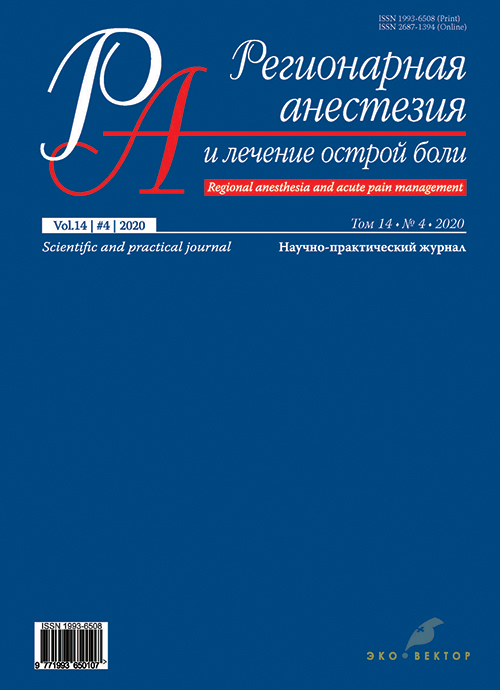Psychological support of patients with chronic pain on multidisciplinary management
- Authors: Khinovker V.V.1, Alkina M.V.1, Chernomurova P.A.1, Gazenkampf A.A.2
-
Affiliations:
- Federal Siberian Research Clinical Centre FMBA of Russia
- 2Krasnoyarsk State Medical University named after Prof. V.F. Voino-Yasenetsky
- Issue: Vol 14, No 4 (2020)
- Pages: 206-216
- Section: Original study articles
- Submitted: 01.03.2021
- Accepted: 01.03.2021
- Published: 08.12.2020
- URL: https://rjraap.com/1993-6508/article/view/62398
- DOI: https://doi.org/10.17816/RA62398
- ID: 62398
Cite item
Abstract
Background. Although pain has been studied extensively, its treatment remains an urgent problem. Pain can be caused by various factors, both at the physiological and psychological levels. Patients with chronic pain develop specific psychological problems. Viewing pain through the prism of a psychosocial approach involves the use and development of new psychotechnologies.
Objective. This study aimed to explore the possibilities of improving the emotional state and reducing pain intensity in patients with chronic back pain using mindfulness and cognitive behavioral therapy techniques.
Materials and methods. The study sample consisted of 30 patients with chronic back pain (20 women, 10 men) who were on outpatient treatment at a pain management center.
Results and discussion. Based on the results of the analysis and generalization of literature sources, we prepared a psychological support program, including cognitive behavioral and “mindfulness” techniques. The program consisted of three blocks: diagnostics, exercises, and repeat diagnostics. Experimental data have shown the possibility and confirmed the effectiveness of reducing levels of depression, anxiety, and pain.
Conclusions. Patients with chronic pain often present with varying levels of depression and anxiety symptoms and a reduced quality of life.
A medical and psychological support program using mindfulness techniques and cognitive behavioral therapy positively influenced the level of anxiety, depression, and pain intensity.
A medical and psychological support program helped patients learned methods of self-regulation and self-relaxation.
Keywords
Full Text
About the authors
Vladimir V. Khinovker
Federal Siberian Research Clinical Centre FMBA of Russia
Author for correspondence.
Email: vhinov@hotmail.com
ORCID iD: 0000-0002-3162-6298
MD, PhD, the Head of the Department of Anesthesiology and Intensive Care, Federal Siberian Research Clinical Centre FMBA of Russia
Russian Federation, 660037, Krasnoyarsk, 26 Kolomenskaya Street, PO Box 6213M. V. Alkina
Federal Siberian Research Clinical Centre FMBA of Russia
Email: vhinov@hotmail.com
ORCID iD: 0000-0001-9168-5823
Russian Federation, 660037, Krasnoyarsk, 26 Kolomenskaya Street, PO Box 6213
P. A. Chernomurova
Federal Siberian Research Clinical Centre FMBA of Russia
Email: vhinov@hotmail.com
ORCID iD: 0000-0001-7592-2390
Russian Federation, 660037, Krasnoyarsk, 26 Kolomenskaya Street, PO Box 6213
A. A. Gazenkampf
2Krasnoyarsk State Medical University named after Prof. V.F. Voino-Yasenetsky
Email: vhinov@hotmail.com
ORCID iD: 0000-0001-8515-2991
Russian Federation, 660022, Krasnoyarsk
References
- Komleva NE, Spirin VF. Quality of life in patients with back pain. Bulletin of the East. Siberian Scientific Center of the Siberian Branch of the Russian Academy of Medical Sciences. 2013;3(91):19–22. (In Russ).
- Rachin AP. Chronic back pain (approaches to diagnosis and therapy). Poliklinika. 2014;5:42–45. (In Russ).
- Danilov AB. Biopsychosocial Model and Chronic Pain. Rossiiskiy zhurnal boli. 2010;1(26):3–7. (In Russ).
- Tokareva AA, Melnikov ME. Study of the psychological correlates of chronic pain syndrome. Bulleten’ sibirskoy meditsiny. 2012;1(11):83–90. (In Russ).
- Zinov’eva OE, Rozhkov DO. A multidisciplinary approach to the management of chronic nonspecific back pain. Regulyarnye vypuski «RMJ».2018;4(2):93–96. (In Russ).
- Shvachkin SD, Lazareva EA. Possibilities of psychotherapy in the complex rehabilitation of patients with chronic back pain. Mediysinskiy al’manakh. 2016;5:179–182. (In Russ).
- Gatchel RJ. Early development of physical and mental deconditioning in painful spinal disorders. Contemporary conservative care for painful spinal disorders. 1991;3:278–289.
- Melzack R. Sensory, motivational and central control determinants of pain: a new conceptual model. The skin senses. 1968;4:423–443.
- Laskov VB, Alekseenko YuV. The role of iatrogenic factors in catastrophizing pain. Integrativnye tendentsii v meditsine i obrazovanii. 2017;4:9. (In Russ).
- Bulyubash ID, Mlyavykh SG. Clinical and psychodiagnostic markers of persistence of chronic pain in the lumbar-sacral region after surgical treatment. Voprosy travmatologii i ortopedii. 2013;1:7–13. (In Russ).
- Golubev VL, Danilov BA. Emotional, sociocultural factors and chronic pain. Regulyarnye vypuski «RMJ». 2014;0:6. (In Russ).
- Danilov BA. New approaches in the treatment of patients with chronic. Lechschiy vrach. 2009;4:34–38. (In Russ).
- Danilov AB. Psychopathology and chronic pain. Consilium medicum. 2008;2:50–55. (In Russ).
- Penner VA, Borisenko VV. Low back pain associated with osteoporosis and the syndromes that accompany it. Ukrainskiy morphologichesliy al’manakh. 2014;4:85–88.
- Dyukova GM. New perspectives in the treatment of chronic pain and depression Consilium Medicum. 2007;8:85–88. (In Russ).
- Vyshlova IA. The results of the use of educational programs in patients with chronic dorsalgia. Kurortnaya meditsina. 2018;4:65–69. (In Russ).
- Sokov EL, Kornilova LE. Features of the personal profile of patients with chronic pain syndrome in the back and lower extremities. Meditsinskii al’manakh. 2014;3:71–73.
- Golovacheva VA, Golovacheva AA. Psychological methods in the treatment of chronic nonspecific pain in the lower back. Nevrologiya, neyropsikhiatriya, psikhosomatika. 2019;1:25–32. (In Russ).
- Robins CJ. Effects of mindfulness-based stress reduction on emotional experience and expression: a randomized controlled trial. J Clin Psychol. 2012;68(1):117–131.
- Kerr CE. Effects of mindfulness meditation training on anticipatory alpha modulation in primary somatosensory cortex. Brain Research Bulletin. 2011;84:96–103.
Supplementary files

















